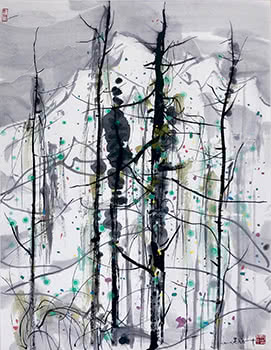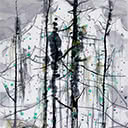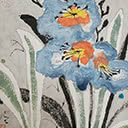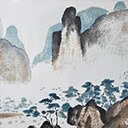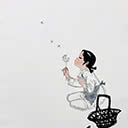Trees and Snow Mountain
86 x 69 cm
est. $400,000 - 600,000
PROVENANCE
Private Collection, Auckland
Purchased from Plum Blossoms (Int'l) Ltd Hong Kong, 27/4/1992
EXHIBITED
Wu Guanzhong - Kaleidoscope, May 16 to 27, 1989
Illustrated on front cover and p. 61
Wu Guanzhong - Kaleidoscope
Plum Blossoms (International) Ltd
Wu Guanzhong (1919-2010) stands as one of the most important artists of twentieth-century China. Born in Jiangsu Province, Wu studied art at the National Academy of Art in Hangzhou (today's China Academy of Art) and, from 1947, in Paris at the École Nationale Supérieure des Beaux-arts. He returned to China after three years and taught at the Central Academy of Fine Arts in Beijing. His works were condemned before and during the Cultural Revolution because his oil paintings did not comply with the political interests of the time. In spite of this he continued to paint and emerged as a national cultural figure whose works came to be celebrated inside and outside China. He is also well known for his eloquent writings on art and creativity that sometimes led to controversies and spawned heated debates among Chinese artists and intellectuals. Wu Guanzhong created works that embody many of the major shifts and tensions in twentieth-century Chinese art-raising questions around individualism, formalism, and the relationship between modernism and cultural traditions.
With a career spanning over sixty years, the selection of paintings in this exhibition focuses on some of his best works in the medium of ink and spans the decades from the mid-1970s to 2004. It is notable that Wu began to work more extensively in ink in the 1970s in his mid-career-turning to a traditional medium at a time when most artists looked to western art for inspiration. The exhibition traces the development of Wu's work during this period with a thematic focus illuminating the rich historical legacy of ink painting in China, and also representing his radical individual style steeped in his strong belief in formalist principles. Wu pushed the boundaries of our understanding of how a traditional medium of ink can be made new for a new century. Wu Guanzhong often compared his revolutionary approach to ink painting to the way a kite is navigated; not flying too far from the ground. The use of ink and wash clearly reveals his solid grounding in the centuries-old tradition of Chinese ink landscape painting.
Monumental mountains in Wu's paintings echo the regal presence of mountain peaks in the iconic landscape painting Early Spring by Guo Xi (1000- ca. 1090), dated to 1072. Some other works by Wu show influences of painters from the Song dynasty (960-1279) to the Qing dynasty (1644-1911) in the compositions and the types of brushstrokes he uses to add a variation in texture and an atmospheric effect. However, he has also created works that are fundamentally different from the tradition, particularly in his use of bright colours, liberal use of wash, and radical compositions based on an interest in formalism.
Where traditional ink paintings emphasized the grandeur and majesty of the natural environment over small-scale pavilions or other architectural elements, the most distinct compositions that Wu created are found in those paintings depicting rural yet grand homes and towns that emphasize a constructed, man- made environment. Rather than including buildings as a small part of painting, he extracted geometric beauty and a structural rhythm from architecture. To Wu, whether artists are painting buildings, mountains, rivers, grass or trees, it is of primary importance that they paint with feeling.
Revolutionary Ink: The Paintings of Wu Guanzhong, The Asia Society Museum exhibition, 2012

